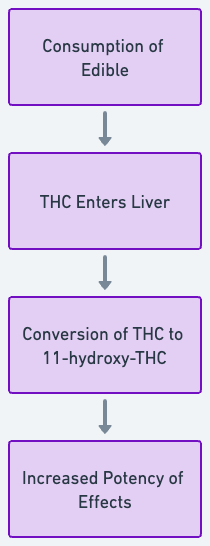
Understanding the Metabolism of THC in Edibles: From Ingestion to Effects
The Importance of Liver Metabolism in Cannabis Edibles
When you consume cannabis through edibles, like a gummy bear or a brownie, the tetrahydrocannabinol (THC)—the compound mainly responsible for cannabis’ psychoactive effects—goes through a fascinating journey. Specifically, it undergoes substantial metabolic transformation in the liver, resulting in a different compound known as 11-hydroxy-THC. This altered compound contributes to the unique psychoactive and therapeutic experiences linked to edible cannabis products. This article breaks down the steps of this metabolic process, to help you understand how and why consuming cannabis edibles leads to distinct effects compared to other forms of ingestion.
Step 1: Ingestion and the Digestive Journey
The journey begins when you ingest a cannabis-infused edible. This food or beverage travels through your digestive system, encountering various enzymes and digestive juices along the way. As it makes its way through the stomach and into the small intestine, the edible is broken down, and the cannabinoids—including THC—are absorbed into the bloodstream.
Step 2: First Stop—The Liver
Once THC enters the bloodstream, it is transported directly to the liver. Here, it encounters a family of enzymes known as the cytochrome P450 system. Among these enzymes, CYP2C9 plays a central role in transforming THC into 11-hydroxy-THC.
Step 3: Birth of 11-hydroxy-THC
CYP2C9 catalyzes the conversion of THC to 11-hydroxy-THC through a chemical process called hydroxylation. In simpler terms, a hydroxyl group (OH) is added to the THC molecule, turning it into 11-hydroxy-THC.
Step 4: Pharmacokinetics and Experience
After its formation, 11-hydroxy-THC enters the bloodstream. What makes this compound intriguing is its high ability to cross the blood-brain barrier, thanks to its fat-soluble nature. This results in a more intense psychoactive experience compared to THC consumed via inhalation. However, there is a catch: the onset of these effects is delayed, generally taking anywhere between 30 minutes to two hours to manifest.
Step 5: The Exit Strategy
Both THC and 11-hydroxy-THC don’t stay in the body indefinitely. They undergo further metabolism to form other by-products. Specifically, 11-hydroxy-THC is further metabolized into THC-COOH, an inactive metabolite. These compounds are eventually excreted through urine and feces.
Conclusion: Individualized Effects and Considerations
Understanding the liver’s role in THC metabolism is essential for gauging the duration and intensity of effects when consuming cannabis edibles. However, it’s important to remember that individual experiences can vary due to factors like metabolic rate, tolerance, and the specific formulation of the edible.
By understanding each step of this process, consumers can make more informed decisions about how to use cannabis edibles, optimizing both the therapeutic benefits and their overall experience.
📗 Note: The diagram is like a pipe—simple but effective. Want a whole cannabis lab of info? Try “The Doctor-Approved Cannabis Handbook” through this link 📗.

Summary Notes
Exploring THC Metabolism in the Liver from Edible Cannabis
The metabolism of THC in the liver, particularly after the consumption of cannabis edibles, involves complex biochemical pathways that transform THC into more potent metabolites, such as 11-hydroxy-THC (11-OH-THC). This conversion significantly influences the intensity, duration, and onset of the effects experienced by edible users. Understanding these processes is crucial for both consumers and medical professionals to ensure safe and effective use of cannabis edibles.
Liver enzymes play a key role in this metabolic transformation, and factors such as liver health, genetic variations, and interactions with other medications can affect the efficiency and outcome of THC metabolism. Safety considerations, especially regarding liver function and potential interactions with dietary factors and medications, are paramount for users of THC edibles.
As research advances, innovations in edible formulations aim to modulate the liver’s conversion of THC, potentially offering more predictable and controlled experiences for users. Education on the liver’s role in THC metabolism is essential for informed consumption, guiding both recreational and medicinal users towards safer practices.
Future studies will continue to delve into the intricacies of THC liver metabolism, seeking to enhance our understanding of how to optimize the therapeutic benefits of cannabis edibles while minimizing adverse effects. This ongoing research promises to inform guidelines, product development, and personalized cannabis therapies, accounting for individual metabolic differences and liver health status.

